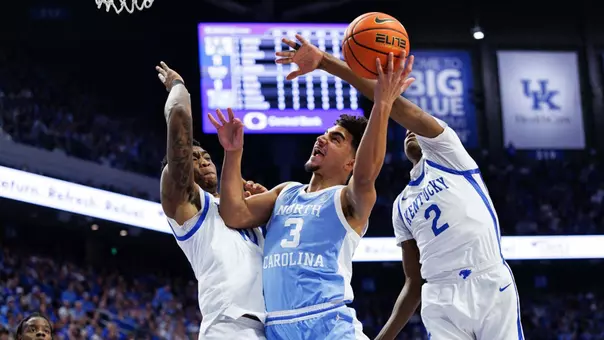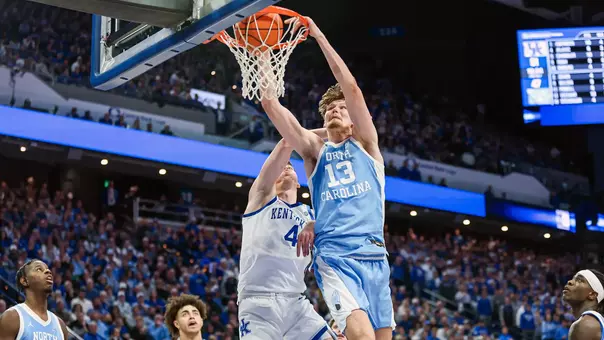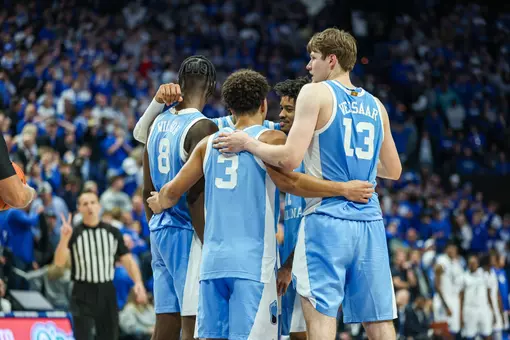University of North Carolina Athletics

Photo by: J.D. Lyon Jr.
Lucas: Rapid Reactions
February 22, 2020 | Men's Basketball, Featured Writers, Adam Lucas
Quick takeaways from Carolina's visit to Louisville.
By Adam Lucas
1. Carolina trailed by as many as 24 points on the way to a 72-55 loss at Louisville.
2. With personnel options limited, Cole Anthony was Carolina's primary and secondary offensive option. The freshman guard took nearly a third of Carolina's shots and finished with 18 points. He made two of his seven three-point shots, including one from a distance that was measured by the Louisville airport radar.
3. With Garrison Brooks out--and not even in the building--due to illness, the Tar Heels had to use the ninth different starting lineup of the season. That's the most different starting combinations in the Roy Williams era. Justin Pierce also was not available due to an ankle injury, meaning Tar Heel scholarship players have now missed 85 games due to injury this season, easily the most in the Williams era.
4. The five who started the game--Cole Anthony, Christian Keeling, Leaky Black, Brandon Robinson and Armando Bacot--had not been on the court together for one second this season prior to the opening tipoff of Saturday's game.
5. Carolina has now lost seven games in a row, the second-longest losing streak in program history. The only longer streak was an eight-game slide during the 1950-51 campaign. Carolina hosts NC State on Tuesday night at the Smith Center.
6. Brooks was averaging 34.6 minutes, so those minutes had to come from somewhere. With that in mind, Walker Miller was solid in limited reserve action, and Carolina also put some very unusual groups on the floor. At one point in the first half, it was Anthony, Keeling, Andrew Platek, Jeremiah Francis and Armando Bacot. That's four guards and a big guy, mostly out of necessity.
7. As you would expect, Carolina's offensive rebounding was severely compromised by the absence of Brooks and the unusual lineups. Carolina missed 16 shots in the first half and rebounded just two, far below their usual ratio that is close to 40 percent. Louisville finished with a 38-29 advantage on the glass, a 14-9 edge in offensive rebounding (even though the Cardinals shot 45.6 from the field as compared to Carolina's sub-40 percent mark) and a 9-6 advantage in second chance points. Armando Bacot led the Tar Heels with nine rebounds.
8. Christian Keeling continued his second half of the season surge. The graduate transfer scored nine points and showed some fight at multiple junctures of the game.
9. Out of necessity, Carolina played five possessions of zone defense in the first half. Louisville didn't score the first two times, but then connected on a dunk and two three-point shots, and the zone went into mothballs.
10. The Tar Heels squandered at least three transition opportunities with turnovers. That poor decision-making is a reason why Carolina has struggled for much of the season in what is usually one of the most consistent parts of the offense. The Tar Heels finished with two fast break points.
11. Carolina turned it over 17 times in total, which largely contributed to Louisville attempting seven more shots than the Tar Heels. The Cardinals held an 18-5 edge in points off turnovers in a game they won by 17 points.
12. Sure, it was the final two minutes of an ACC blowout. But the final five of KJ Smith, Caleb Ellis, Robbie O'Han, Ryan McAdoo and Shea Rush showed the type of effort Carolina could have used throughout the game. Ellis dove on the floor for a loose ball, Smith and Ellis connected on a very nice basket, and Smith battled under the rim and knocked in a couple of free throws for Carolina's final points. It doesn't change the outcome of the game, but it was nice to see.
1. Carolina trailed by as many as 24 points on the way to a 72-55 loss at Louisville.
2. With personnel options limited, Cole Anthony was Carolina's primary and secondary offensive option. The freshman guard took nearly a third of Carolina's shots and finished with 18 points. He made two of his seven three-point shots, including one from a distance that was measured by the Louisville airport radar.
3. With Garrison Brooks out--and not even in the building--due to illness, the Tar Heels had to use the ninth different starting lineup of the season. That's the most different starting combinations in the Roy Williams era. Justin Pierce also was not available due to an ankle injury, meaning Tar Heel scholarship players have now missed 85 games due to injury this season, easily the most in the Williams era.
4. The five who started the game--Cole Anthony, Christian Keeling, Leaky Black, Brandon Robinson and Armando Bacot--had not been on the court together for one second this season prior to the opening tipoff of Saturday's game.
5. Carolina has now lost seven games in a row, the second-longest losing streak in program history. The only longer streak was an eight-game slide during the 1950-51 campaign. Carolina hosts NC State on Tuesday night at the Smith Center.
6. Brooks was averaging 34.6 minutes, so those minutes had to come from somewhere. With that in mind, Walker Miller was solid in limited reserve action, and Carolina also put some very unusual groups on the floor. At one point in the first half, it was Anthony, Keeling, Andrew Platek, Jeremiah Francis and Armando Bacot. That's four guards and a big guy, mostly out of necessity.
7. As you would expect, Carolina's offensive rebounding was severely compromised by the absence of Brooks and the unusual lineups. Carolina missed 16 shots in the first half and rebounded just two, far below their usual ratio that is close to 40 percent. Louisville finished with a 38-29 advantage on the glass, a 14-9 edge in offensive rebounding (even though the Cardinals shot 45.6 from the field as compared to Carolina's sub-40 percent mark) and a 9-6 advantage in second chance points. Armando Bacot led the Tar Heels with nine rebounds.
8. Christian Keeling continued his second half of the season surge. The graduate transfer scored nine points and showed some fight at multiple junctures of the game.
9. Out of necessity, Carolina played five possessions of zone defense in the first half. Louisville didn't score the first two times, but then connected on a dunk and two three-point shots, and the zone went into mothballs.
10. The Tar Heels squandered at least three transition opportunities with turnovers. That poor decision-making is a reason why Carolina has struggled for much of the season in what is usually one of the most consistent parts of the offense. The Tar Heels finished with two fast break points.
11. Carolina turned it over 17 times in total, which largely contributed to Louisville attempting seven more shots than the Tar Heels. The Cardinals held an 18-5 edge in points off turnovers in a game they won by 17 points.
12. Sure, it was the final two minutes of an ACC blowout. But the final five of KJ Smith, Caleb Ellis, Robbie O'Han, Ryan McAdoo and Shea Rush showed the type of effort Carolina could have used throughout the game. Ellis dove on the floor for a loose ball, Smith and Ellis connected on a very nice basket, and Smith battled under the rim and knocked in a couple of free throws for Carolina's final points. It doesn't change the outcome of the game, but it was nice to see.
Players Mentioned
Carolina Insider - Football Signing Day Discussion (Full Segment) - December 5, 2025
Friday, December 05
Carolina Insider - Men's Basketball vs. Georgetown Preview (Full Segment) - December 5, 2025
Friday, December 05
Carolina Insider - Interview with Jimmy Black (Full Segment) - December 5, 2025
Friday, December 05
WBB: Post-Texas Press Conference - December 4, 2025
Friday, December 05




























